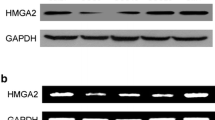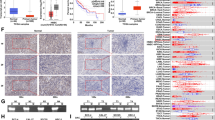Abstract
COX-2 induces the proliferation and invasion of oral squamous cell carcinoma. In the present study, the role of the COX-2 gene in the tongue cancer cell proliferation and invasion was investigated. A short hairpin RNA (shRNA)method was used to knock down COX-2 gene expression and investigate the relationship between COX-2 and VEGF-C, and the role of the COX-2 gene for proliferation and invasion was also investigated in the tongue cancer cell Tca8113. COX-2 gene overexpressed in tongue cancer cell line. Suppressing the expression of COX-2 by shRNA could decrease cell proliferation comparing with control shRNA. Nevertheless, depressing COX-2 gene expression by shRNA reduced VEGF-C expression on both mRNA and protein levels. VEGF-C gene expression could be regulated by COX-2 gene. Our results suggested that COX-2 played essential roles in the proliferation and metastasis of tongue cancer, and COX-2 could serve as a potential chemotherapy target for tongue cancer.








Similar content being viewed by others
References
Kruaysawat W, Aekplakorn W, Chapman RS. Survival time and prognostic factors of oral cancer in Ubon Ratchathani cancer center. J Med Assoc Thai. 2010;93(3):278–84.
Sun CZ, Chen FJ, Zeng ZY, Deng LF, Yang AK, Chen YF. Treatment and prognostic analysis of 92 cases with advanced mobile tongue squamous cell carcinoma. Zhonghua Kou Qiang Yi Xue Za Zhi. 2006;41(11):650–3.
Estilo CL, O-charoenrat P, Talbot S, Socci ND, Carlson DL, Ghossein R, Williams T, Yonekawa Y, Ramanathan Y, Boyle JO, Kraus DH, patel S, Shaha AR, Wong RJ, Huryn JM, Shah JP, Singh B. Oral tongue cancer gene expression profiling: identification of novel potential prognosticators by oligonucleotide microarray analysis. BMC Cancer. 2009;12(9):11.
Thun MJ, Henley SJ, Patrono C. Nonsteroidal anti-inflammatory drugs as anticancer agents: mechanistic, pharmacologic, and clinical issues. J Natl Cancer Inst. 2002;94(4):252–66.
Wang R, Wang X, Lin F, Gao P, Dong K, Zhang HZ. shRNA-targeted cyclooxygenase (COX)-2 inhibits proliferation, reduces invasion and enhances chemosensitivity in laryngeal carcinoma cells. Mol Cell Biochem. 2008;317(1–2):179–88.
Zhao X, Goswami M, Pokhriyal N, Ma H, Du H, Yao J, Victor TA, Polyak K, Sturgis CD, Band H, Band V. Cyclooxygenase-2 expression during immortalization and breast cancer progression. Cancer Res. 2008;68(2):467–75.
Patel S, Chiplunkar S. Role of cyclooxygenase-2 in tumor progression and immune regulation in lung cancer. Indian J Biochem Biophys. 2007;44(6):419–28.
Forones NM, Kawamura KY, Segreto HR, Artigiani Neto R, Focchi GR, Oshima CT. Expression of COX-2 in stomach carcinogenesis. J Gastrointest Cancer. 2008;39(1–4):4–10.
Miyashita M, Makino H, Katsuta M, Nomura T, Shinji S, Kashiwabara M, Takahashi K, Kudo M, Ishiwata T, Naito Z, Tajiri T. Cyclo-oxygenase-2 over-expression is associated with human esophageal squamous cell carcinoma. J Nippon Med Sch. 2006;73(6):308–13.
Yamac D, Celenkoglu G, Coskun U, Akyurek N, Akcali Z, Dursun A, Koybasioglu F. Prognostic importance of COX-2 expression in patients with colorectal cancer. Pathol Res Pract. 2005;201(7):497–502.
Menczer J. Cox-2 expression in ovarian malignancies: a review of the clinical aspects. Eur J Obstet Gynecol Reprod Biol. 2009;146(2):129–312.
Kern MA, Schirmacher P, Breinig M. Significance of cyclooxygenase-2 as a chemotherapeutic target in hepatocellular carcinoma. Verh Dtsch Ges Pathol. 2007;91:257–68.
Cao.Y, Prescott SM. Many action of cyclooxygenase-2 in cellular dynamics and cancer. J Cell Physiol. 2002;190(3):279–86.
Eberhart CE, Coffey RJ, Radhika A, Giardiello FM, Ferrenbach S, DuBois RN. Up-regulation of cyclooxygenase 2 gene expression in human colorectal adenomas and adenocarcinomas. Gastroenterology. 1994;107(4):1183–888.
Evans JF, Kargman SL. Cancer and cyclooxygenase-2 (COX-2) inhibition. Curr Pharm Des. 2004;10(6):627–34.
Prescott SM. Is cyclooxygenase-2 the alpha and the omega in cancer? J Clin Invest. 2000;105(11):1511–3.
Li WZ, Huo QJ, Wang XY, Xu F. (2010).Inhibitive effect of celecoxib on the adhesion and invasion of human tongue squamous carcinoma cells to extracellular matrix via down regulation of MMP-2 expression. Prostaglandins Other Lipid Mediat (Epub ahead of print).
Kwak YE, Jeon NK, Kim J, Lee EJ. The cyclooxygenase-2 selective inhibitor celecoxib suppresses proliferation and invasiveness in the human oral squamous carcinoma. Ann N Y Acad Sci. 2007;1095:99–112.
Stöllberger C, Finsterer J. Side effects of conventional nonsteroidal anti-inflammatory drugs and celecoxib: more similarities than differences. South Med J. 2004;97(2):209.
Chang CH, Shau WY, Kuo CW, Chen ST, Lai. Increased risk of stroke associated with nonsteroidal anti-inflammatory drugs: a nationwide case-crossover study. Stroke. 2010;41(9):1884–90.
Bhattacharjee RN, Timoshenko AV, Cai J, Lala PK. (2010) Relationship between cyclooxygenase-2 and human epidermal growth factor receptor 2 in vascular endothelial growth factor C up-regulation and lymphangiogenesis in human breast cancer. Cancer Sci (Epub ahead of print).
Di JM, Zhou J, Zhou XL, Gao X, Shao CQ, Pang J, Sun QP, Zhang Y, Ruan XX. Cyclooxygenase-2 expression is associated with vascular endothelial growth factor-C and lymph node metastases in human prostate cancer. Arch Med Res. 2009;40(4):268–75.
Bruno T, Desantis A, Bossi G, Di Agostino S, Sorino C, De Nicola F, Iezzi S, Franchitto A, Benassi B, Galanti S, La Rosa F, Floridi A, Bellacosa A, Passananti C, Blandino G, Fanciulli M. Che-1 promotes tumor cell survival by sustaining mutant p53 transcription and inhibiting DNA damage response activation. Cancer Cell. 2010;18(2):122–34.
Abbasi M, Lavasanifar A, Berthiaume LG, Weinfeld M, Uludağ H. (2010) Cationic polymer-mediated small interfering RNA delivery for P-glycoprotein down-regulation in tumor cells. Cancer (Epub ahead of print).
Wang YH, Chen YF, Guo ZM, Zhang Q, Liu TR, Chen FJ. Reasons for recurrence and prognostic analysis of early stage squamous cell carcinoma of the oral tongue. Ai Zheng. 2009;28(5):524–7.
Alitalo K, Tammela T, Petrova TV. Lymphangiogenesis in development and human disease. Nature. 2005;438(7070):946–53.
Achen MG, Stacker SA. Tumor lymphangiogenesis and metastatic spread-new players begin to emerge. Int J Cancer. 2006;119(8):1755–60.
Pepper MS, Tille JC, Nisato R, Skobe M. Lymphangiogenesis and tumor metastasis. Cell Tissue Res. 2003;314(1):167–77.
Yonemura Y, Endo Y, Fujita H, Fushida S, Ninomiya I, Bandou E, Taniguchi K, Miwa K, Ohoyama S, Sugiyama K, Sasaki T. Role of vascular endothelial growth factor C expression in the development of lymph node metastasis in gastric cancer. Clin Cancer Res. 1999;5(7):1823–9.
Su JL, Shih JY, Yen ML, Jeng YM, Chang CC, Hsieh CY, Wei LH, Yang PC, Kuo ML. Cyclooxygenase-2 induces EP-1 and HER-2/Neu-dependent vascular endothelial growth factor-c up-regu-latin: a novel mechanism of lymphangiogensis in lung adenocarcinomn. Cancer Res. 2004;64(2):554–64.
Acknowledgments
This study has been supported by the Guangdong for Natural Scientific Fund (7301082) of China.
Conflict of interest
All authors declare that they have no conflicts of interest.
Author information
Authors and Affiliations
Corresponding author
Additional information
Yan-Hong Wang and Ming-Wei Wu contributed equally to the article as first author.
Rights and permissions
About this article
Cite this article
Wang, YH., Wu, MW., Yang, AK. et al. COX-2 Gene increases tongue cancer cell proliferation and invasion through VEGF-C pathway. Med Oncol 28 (Suppl 1), 360–366 (2011). https://doi.org/10.1007/s12032-010-9737-3
Received:
Accepted:
Published:
Issue Date:
DOI: https://doi.org/10.1007/s12032-010-9737-3




